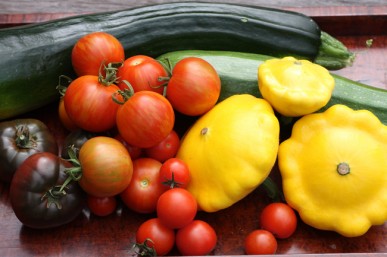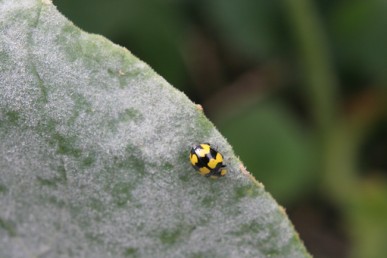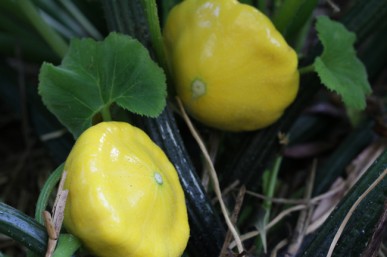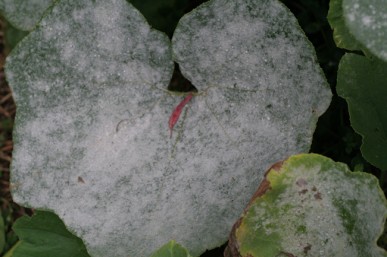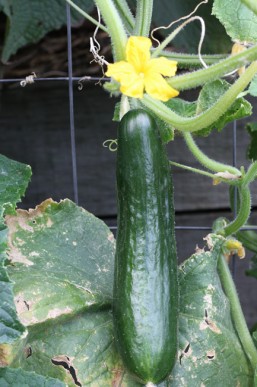I’ve had a cornucopia of cucurbits this year, with lots of ‘Black Beauty’ zucchini and and bright yellow button squash. The pumpkins are not producing as prolifically because I planted them in an out of the way position with not enough sun, but the plants are still growing and the pumpkins are getting bigger. Unfortunately, for the last few weeks the powdery mildew has also been growing. Powdery mildew is a fungus that attacks cucurbits (zucchini, marrow, pumpkin, cucumber etc) and grapevines, some fruit trees and a range of other plants including begonias and roses. It first appears as pale grey spots on the surface of leaves, spreading to cover the whole leaf and stem. If untreated, eventually the whole plant will shrivel, brown and die. Powdery mildew is most prevalent in moderately dry regions, when the weather starts to cool in autumn and where water sits on foliage for long periods. Almost counterintuitively, it is less likely to be a problem in wet weather as well as very hot, dry weather.
The first sign I had of it’s presence a couple of weeks ago were the delightful small yellow and black ladybird Illeis galbula. These cute bugs feed exclusively on powdery mildew (such an unexciting diet, imagine spending your whole life eating nothing but powdery mildew!). Its almost worth having this fungal problem just so these ladybirds can find a home and food in your garden. As soon as I realised that powdery mildew was around, I carefully cut out affected leaves and stems, and instead of putting them into the bin (which is what you should do to stop it spreading), I put them into a remote corner well away from anything else that could be affected. This meant that the ladybirds could keep feeding and build up their populations and so come back to the plants when they became reinfected. One thing I have learnt is that in our climate at this time of year, you can never completely rid your garden of powdery mildew. But you can slow it down and get a few more weeks harvest from your plants.
Once you’ve removed the obviously affected leaves, spray the rest of the plant with nettle or milk spray. I start with milk and alternate with nettle. See the recipes below. Always spray in the morning or you might exacerbate the problem. Otherwise, don’t water the leaves especially in the evening and thin them out so they are not so crowded.
Other sprays that have been used to control powdery mildew are allocasuarina, bicarbonate of soda, chamomile, chives, elder, garlic chives, hyssop, mustards and white cedar.
Milk spray
In the 1990s Wagner Bettiol of the Brazillian Agricultural Research Corporation noticed that byproducts from milk processing factories killed powdery mildew on zucchini crops. His subsequent experiments showed that it was not only as effective as registered commercial fungicides but that it also acted as foliar fertilizer and boosted the plants immune system. In Australia milk spray has been trialled on crops like wine grapes in several Australian states. It has been found to be as effective against powdery mildew as non-organic fungicides on some grape varieties in most conditions. Other trials have also shown that there is negligible difference between full cream, skinny and even powdered milk.
Recipe Combine I part milk (preferably organic) with 9 parts water and use immediately. Spray the entire leaf, top and underneath, once a week. Spraying is more effective if plants are not grown too closely together and if the spray is used as soon as the problem occurs.
Nettle spray
The perennial stinging nettle Urtica dioica grows from a spreading rootstock to 1m in height in good conditions. The opposite leaves are dark green, crinkled and toothed and have a pointed tip. The whole plant is downy in appearance and covered with stinging spines, which can be very painful when brushed against. An antidote for a nettle sting is the juice of the nettle itself but dock, rosemary, mint or sage leaves rubbed on the wound will also relieve the sting. Nettle spray acts as a mild fungicide and general tonic, making plants more resistant to diseases and pests. It is sprayed on leaves or watered around plants to prevent fungal attack, especially powdery mildew.
Recipe Cover a firmly packed cupful of chopped nettles with 1L of water. Bring to the boil and simmer for 10 minutes. Cool, strain and use within a few days.

